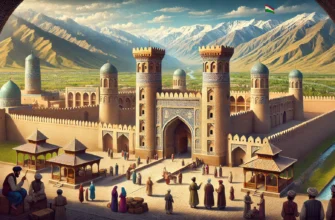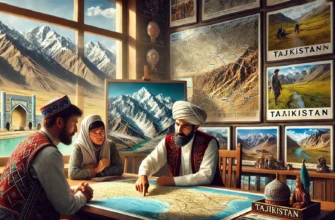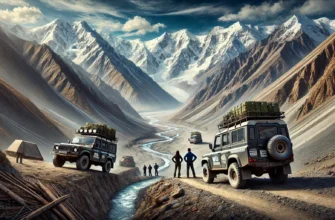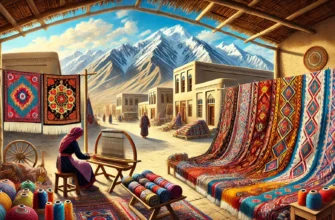Cradled by towering mountain ranges and ancient Silk Road trails, Tajikistan is an enigma waiting to be unraveled by intrepid travelers. Despite being one of Central Asia’s lesser-explored destinations, it offers a tapestry of cultural richness, breathtaking landscapes, and untapped experiences that captivate the imagination. This guide is crafted for those curious about venturing into a land where tradition meets adventure, providing a comprehensive look at what it means to explore the hidden heart of Asia.
Understanding the nuances of traveling in Tajikistan is essential for any visitor. From appreciating the safety and risks involved, such as areas like Gorno Badakhshan and the border with Kyrgyzstan to observing cultural norms and mastering the logistical aspects of travel, careful planning can transform your visit from daunting to delightful. Moreover, with considerations for different travelers, including women and 2SLGBTQI+ individuals, getting familiar with local customs and safety tips can enhance your journey.
Join us as we uncover Tajikistan’s top destinations and experiences, from the majestic Pamir Mountains to its vibrant festivals, and provide insights on everything from entry regulations to budgeting. Whether you’re plotting an adventurous trek or a cultural exploration, our article is your gateway to crafting a memorable Tajikistan itinerary that balances safety, cultural depth, and the thrill of discovery.
Understanding Safety and Risks
Travelers to Tajikistan should be aware of safety challenges. There is a risk of terrorism and civil unrest, calling for vigilance. Prioritize safety by adhering to official warnings and instructions from local authorities. The Foreign, Commonwealth & Development Office (FCDO) offers travel advice to help make informed decisions. Animal-related diseases, such as rabies, exist in Tajikistan, so consider vaccinations before traveling. Snow in winter and spring can make some areas hard to reach by land. Always stay updated on weather conditions and plan routes accordingly.
Regional Advisories
Tajikistan has some regional safety concerns. Exercise caution because of terrorism and civil unrest threats. Avoid traveling within 10 km of the Afghan border due to security risks. The Gorno Badakhshan Autonomous Oblast is another area where non-essential travel is not recommended due to unrest and terrorism. Similarly, steer clear of areas within 30 km of the Kyrgyzstan border because of potential armed clashes. Being aware of these alerts helps travelers avoid dangerous areas and plan safer routes.
Areas to Avoid: Gorno Badakhshan and Border with Kyrgyzstan
Traveling in the Gorno Badakhshan Autonomous Oblast requires careful planning. The area is prone to civil unrest and terrorism. Non-essential travel within 30 km of the Kyrgyzstan border should be avoided because of rising tensions and risk of clashes. A special travel permit is also necessary for entry into Gorno Badakhshan. These permits might not be promptly issued due to security concerns. Understanding these requirements is crucial for any planned travel in these regions.
Crime and Security Issues
Crime in Tajikistan presents several concerns for travelers. Terrorism and unrest are present risks, especially in the Gorno Badakhshan region. Travelers should watch out for petty crimes like pickpocketing, especially in crowded places. Violent crime against tourists is rare but not impossible. Be cautious of organized crime linked to drug trafficking in border areas. Police may lack adequate resources, sometimes leading to requests for bribes. Staying vigilant and aware of surroundings can help minimize risks.
Safety Considerations for Women Travelers
Women traveling in Tajikistan should be aware of certain cultural and safety considerations. Solo female travelers might face unwanted attention or harassment. Consider traveling in groups and avoid venturing out alone at night. In Dushanbe, catcalling can happen but is best ignored. Outside Dushanbe, modest clothing is advisable; avoid shorts and short skirts. While headscarves are usually not required, they might be expected in mosques. A fake wedding ring might deter unwanted male attention.
2SLGBTQI+ Travel Precautions
Tajikistan presents some challenges for 2SLGBTQI+ travelers. While same-sex relationships are legal, there might be societal discrimination based on sexual orientation. To mitigate risks, travel prudently and avoid public displays of affection. Tajikistan’s society is conservative, so dressing modestly and adhering to local customs is important. Evaluate potential risks and seek local advice when unsure about cultural norms related to dress and behavior. Understanding these aspects can help ensure a safer and more respectful travel experience.
Cultural Considerations
Traveling to Tajikistan requires an awareness of local customs and cultural norms. This mountainous country has conservative codes of dress and behavior, deeply influenced by its Muslim heritage. To avoid any cultural misunderstandings, it’s crucial for visitors to blend in and respect local traditions. Whether it’s the way you dress or behave in public, understanding these cultural nuances will enrich your experience. Also, always carry a copy of your travel documents including your passport and tourist visa. Let’s dive deeper into these important aspects of travel etiquette.
Respecting Local Traditions and Customs
Tajikistan is a Muslim country where Islamic practices are observed, especially outside larger cities. Respecting these social and religious customs is key for any traveler. Always dress modestly and seek local advice if you’re unsure about what’s appropriate. Photographing sensitive sites, like government buildings, is prohibited, so always ask before taking pictures. Observing these practices not only shows respect but also enhances your travel experience by fostering a deeper connection with the local culture.
Dress Code and Behavior
In Tajikistan, dressing conservatively is not just a suggestion but a requirement in both rural and urban areas. Women should cover their shoulders and knees, and wearing headscarves is common. Public behavior is governed by strict rules, so avoid smoking in public areas. Drinking and driving is also illegal, emphasizing the importance of adhering to local laws. When in doubt, consult locals to ensure your attire and actions align with cultural expectations. This approach will help you avoid any unintended offenses and make your stay a positive one.
Language and Communication
Tajikistan’s official language is Tajik, which uses the Cyrillic script. Russian is widely used for inter-ethnic communication and is common in government and business. While English is not widely spoken, familiarity with Dari or Farsi can be helpful, as they are dialects of Persian, similar to Tajik. For effective communication, knowing some basic phrases in Tajik or Russian is valuable. This linguistic knowledge can significantly enhance your ability to navigate and enjoy your time in the country, especially outside of major cities where English is less prevalent.
Planning Your Visit
Tajikistan, with its rich culture and stunning mountain landscapes, offers visitors a unique experience. Citizens of many countries, including those from the European Union, USA, and Australia, can travel visa-free for up to 30 days. Those from India and Singapore can utilize the e-visa option for longer stays. The peak time for tourists is between late May and October, perfect for hiking and exploring the natural beauty. For winter sports enthusiasts, the best time to visit is from November to March. It’s crucial for travelers to be alert in crowded areas to prevent petty crimes. Understanding these factors will ensure a smooth and enjoyable journey in this intriguing country.
Visa Requirements and Entry Regulations
Travelers eager to explore Tajikistan can enjoy a streamlined entry process, especially if their stay is brief. For up to 30 days, visitors from 52 countries do not need a visa. Longer stays or multiple entries require a visa. It’s essential to register with local authorities within ten working days of arrival. This legal step ensures compliance and a trouble-free visit.
Visitors aiming to explore the unique Gorno-Badakhshan Autonomous Oblast (GBAO) must obtain a separate permit. This area offers exceptional natural beauty but necessitates specific paperwork. Your passport should be valid for at least six months past your entry date. Additionally, it is wise to have two blank pages for entry stamps. With these rules in mind, travelers can enjoy a seamless journey.
Best Times to Visit: Weather and Seasons
Tajikistan provides diverse experiences throughout the year, with each season offering distinct advantages. The best time for outdoor activities and trekking is between late May and October when the weather is usually mild. This period allows for hiking and exploring the scenic landscapes without extreme temperatures.
During the summer months, regions like Khujand and Dushanbe can be hot, with temperatures peaking at 40°C. Yet, the weather remains suitable for most outdoor plans. Caution is advised during early summer when river crossings may become perilous. Alternatively, winter in Tajikistan is ideal for snow sports lovers, especially in the Pamir region, where temperatures drop between -20°C and -40°C. Be prepared for cold spells during this time, particularly if navigating routes like the Pamir Highway. Spring and autumn offer mild weather, although spring may bring rainy conditions, leading to travel disruptions. Planning with the weather in mind ensures travelers get the most out of their Tajikistan experience.
Currency and Banking Tips
Understanding Tajikistan’s financial landscape is crucial for a smooth trip. The official currency is the Tajik Somoni, and transactions must be conducted using this currency. Cash is king here, with credit cards only accepted in larger establishments in major cities. Visitors should plan to use cash daily and exchange currency at officially authorized locations.
ATMs are becoming more common in Dushanbe and larger cities, but rural areas may lack this convenience. Most ATMs accept Visa cards more readily than others. Carrying US dollars is practical, as they are widely accepted for exchange. Euros and Russian rubles can also be exchanged, but availability might be limited. Ensuring you have adequate cash and understanding banking practices will make your visit more efficient and enjoyable.
Exploring Tajikistan
Tajikistan is a land of incredible natural beauty and diverse cultures. With its mountainous terrain, it attracts outdoor enthusiasts and history buffs alike. The best time to visit is from late May to October. During these months, clear skies and warm temperatures make it perfect for trekking and exploring. Dushanbe International Airport serves as the main gateway to the country. Here, travelers can find connections from major cities such as Moscow, Istanbul, and Dubai. While in Tajikistan, local shared taxis, known as “marshrutkas,” offer an efficient way to travel between cities.
Top Destinations: Pamir Mountains and More
The Pamir Mountains are one of Tajikistan’s most captivating destinations. Known for their breathtaking landscapes, these mountains provide opportunities for trekking and exploring remote villages. Visitors can engage with the Pamir people, who are known for their unique traditions and languages. Dushanbe, the capital, offers winter sports at Safed Dara, the country’s ski resort. It caters to skiing, snowboarding, and even ice skating enthusiasts. The Tajik National Park and the ancient site of Sarazm, a UNESCO World Heritage site, are must-visit locations. For road trip lovers, traveling the M-41, or Pamir Highway, offers an unforgettable drive. It passes through some of the world’s most remote and stunning mountain scenery.
Hidden Gems and Off-the-Beaten-Path Adventures
For adventurers seeking hidden gems, Tajikistan offers the Pamir and Fann Mountains. Here, day hikes and multi-day treks through stunning alpine landscapes abound. The Pamir Highway offers epic road trips through secluded terrains. Known as one of the highest roads globally, its most beautiful segments lie within Tajikistan. Travelers can find nomadic yurt camps in the Tajik Pamirs, experiencing the Kyrgyz nomadic lifestyle firsthand. The journey from Osh to Dushanbe includes breathtaking high-altitude passes like Ak-Baital Pass. This route reaches 4,655 meters, providing awe-inspiring views. The Jisue and Wakhan Valleys are cultural and scenic treasures. These valleys offer unique experiences for those venturing off the beaten path.
Experiencing Local Culture and Festivals
Exploring Tajikistan’s culture requires understanding and respect. Local customs are important, and travelers should avoid public displays of affection, as they might offend locals. During Ramadan, a significant Islamic month, it’s respectful to avoid eating or drinking in public if you’re not fasting. Dressing conservatively and seeking local advice can ensure cultural sensitivity. While same-sex relationships are legally recognized, discretion is advised regarding public displays of affection. Engaging with local communities can provide enriching cultural experiences. Accepting hospitality from villagers in places like Namadgut is a wonderful way to connect with the culture.
Navigating the Country
Tajikistan, a stunning yet rugged destination, offers travelers various ways to explore its natural beauty and major cities. Internal flights are a quick travel option, with routes like Dushanbe to Khujand or Khorog. Roads can be tricky due to poor conditions and petrol quality, but self-driving remains a practical choice if you are prepared. During winter and spring, many high passes become inaccessible due to weather conditions. The train service to Uzbekistan has resumed, providing an alternate mode of travel. If heading to remote areas like the Gorno-Badakhshan Autonomous Oblast, securing a government permit is crucial. Travelers need to keep an eye on regional security conditions as well.
Transportation Options: Public and Taxi
Public transportation in Tajikistan is limited and can be unreliable. Trains and buses often face issues like delays and safety concerns. Travelers who prefer taxis will find both licensed and unlicensed options available. However, distinguishing between the two can sometimes be difficult. Drivers often refuse to use official meters, adding a layer of complexity to travel plans. In larger cities such as Dushanbe, taxis can be booked using apps like Maxim, Rakhsh, and Yak. Booking through the app ensures that you get a metered taxi, bringing some predictability to your travels.
Shared taxis, also known as marshrutkas, are a popular yet crowded option. While affordable, they tend to be overcrowded and lack seatbelts, often leading to reckless driving. If you are traveling between cities, you can wait for the shared taxi to fill up or pay for four seats to use it as your private taxi. This is often less costly than hiring a private taxi service and may make your trip more comfortable.
Self-Driving Tips and Road Conditions
Driving yourself in Tajikistan brings freedom but also demands caution. The country’s roads are often in poor condition, especially in mountainous and rural areas. An off-road vehicle is usually the safest choice given the zigzagging roads and rugged terrain. Travel times may be longer than expected because of these conditions. Winter months can bring blocked routes due to snow, while spring ushers in risks of rockslides and mudslides. The Pamir Highway, known for its scenic views, stays open year-round but requires drivers to prepare for unpredictable weather and roadblocks.
Random stops by local police are common, and officers may demand small bribes. Preparing for such encounters is advisable. Having the right travel documents and a clear understanding of your route can ease the travel experience. Before setting off, make sure to check the weather conditions and any travel advisories to ensure safe and smooth travel. With a bit of preparation, exploring Tajikistan by car can be an unforgettable adventure.
Accommodations and Budgeting
Traveling to Tajikistan offers a diverse range of accommodation options to suit various budgets. From affordable hostels to more upscale hotels, travelers can find lodgings that fit their needs. Whether you plan to explore the bustling streets of Dushanbe or the serene landscapes of Khorog, knowing your lodging choices is crucial. A sample budget for a week-long trip can be kept around $295. This budget covers basic accommodation, meals, and transportation, leaving room for the unexpected. Planning your stay wisely will ensure a comfortable and rewarding journey through this fascinating country.
Types of Lodging: From Hotels to Guesthouses
In Tajikistan, travelers can choose from a variety of lodging types. Hostels in larger cities, such as Dushanbe and Khujand, are both affordable and social. Prices hover around $20 per night, making them a great option for budget travelers. Guesthouses and homestays are another economical choice, costing about $150 for a week. These options provide a deeper connection to local culture.
For those seeking a bit more comfort, hotels are available across various cities. A hotel room starts at around $30 per night. This allows you to enjoy more amenities without breaking the bank. Travelers who prefer nature can consider camping, which is widely tolerated. This option offers an adventurous way to enjoy Tajikistan’s stunning landscapes.
Cost-Effective Travel Tips
Traveling in Tajikistan doesn’t have to be expensive. By following a few cost-effective tips, you can stretch your budget further. One way to save is by using public transportation instead of costly taxis. This option is often cheaper and provides a more authentic experience. Also, consider eating at local markets or smaller eateries. These spots typically offer delicious meals at a fraction of the price of tourist restaurants.
Another tip is to plan your visit during the summer months. This season is not only ideal for exploring but can also help you avoid higher rates that come with the influx of tourists. Finally, ensure you have travel insurance to cover unexpected emergencies. This tip can save you a lot on unforeseen expenses while keeping your trip smooth and enjoyable.
Health and Safety Precautions
Tajikistan’s rugged landscapes are breathtaking but require careful planning for a safe journey. The country is prone to natural hazards like mudslides and landslides, especially in spring due to weather changes. Autumn and winter pose additional risks such as heavy snowfall and avalanches. Public transportation, particularly shared taxis, can be unreliable and risky due to reckless driving. Mobile phone coverage is spotty in remote areas, making medical emergencies challenging. It’s essential to stay alert and informed about current conditions and to have a plan in place. Being cautious and prepared can ensure a more enjoyable, worry-free trip.
Vaccinations and Health Preparations
Before heading to Tajikistan, visitors should consult TravelHealthPro for vaccination requirements and health advice. Travelers staying over 90 days must present a medical certificate proving they are HIV-free. However, in-country testing is discouraged due to inadequate medical services. In the Pamirs, travelers often face diarrhea, so maintaining hygiene and food safety is vital. The high altitudes, particularly on the Pamir Highway, pose a risk of altitude sickness, so acclimatizing slowly is best. Always drink bottled or filtered water to avoid waterborne diseases, as tap water is unsafe. Being prepared health-wise can greatly improve your travel experience.
Emergency Contacts and Support
Tajikistan offers breathtaking landscapes for trekkers and adventure seekers. Yet, emergencies should not be overlooked. For instance, in cases of international child abduction, seeking legal advice in Canada and Tajikistan is crucial, as Canadian consular officials have limited power in such matters. The Emergency Watch and Response Center can provide help through local Canadian government offices. Travelers should inform someone about their trekking plans due to limited mobile signals. Interactions with law enforcement, particularly in Dushanbe, sometimes involve bribe requests. Tourists should handle these situations with discretion and caution. Proper preparation ensures better emergency support when needed.
FAQs
Traveling to Tajikistan requires some preparation to ensure a smooth journey. This country, known for its beautiful mountain ranges and rich culture, welcomes travelers from around the world. To make sure your trip goes without a hitch, you should know about travel documents, visa regulations, and other entry requirements. For those entering the Gorno-Badakhshan Autonomous Oblast, a special permit is necessary. Furthermore, ensure your passport is valid for at least six months beyond arrival and contains two blank pages.
What should I pack for a trip to Tajikistan?
Packing for Tajikistan involves careful consideration of its variable climate and cultural norms. The weather can change depending on the season and region. In the winter months, temperatures can drop, making warm layers essential. During the summer months, lightweight clothing and sunscreen will keep you comfortable. Remember, many areas in Tajikistan do not accept credit cards. Carry cash in the local currency, the somoni.
It’s also important to carry your travel documents at all times. Military and police officers often conduct checks. For health reasons, it’s advised not to drink tap water. Consider bringing a water filter bottle. Lastly, Tajikistan is a Muslim country, so dress modestly, especially in small towns. Long trousers or skirts and avoiding sleeveless tops show respect for the local culture.









